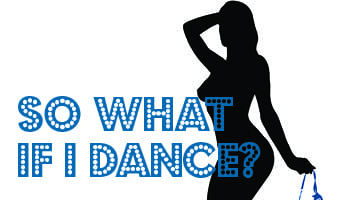SO WHAT IF I DANCE: The first time I went into a strip club was in August 2011 at the Edinburgh Festival Fringe. I went at 3 o’clock in the afternoon, and the club side of it was not open yet. Instead, it was playing host to an exhibition that was part of the Fringe, and which had been championed by the dancers that worked there. It was a photography display showing not only them at work, but also their personal lives; buying groceries, doing the laundry, and so on. The dancers were hoping to combat some of the negative media that had been coming their way.
I left with a a lot of food for thought. I had always thought of strip clubs as another form of theatre – a performance that could be enjoyed as a group watching a stage show or in private, one on one. I went back the next night to visit the club and experience its pleasures and performances as a client – and I left with much the same impression. However, the exhibition had made me realise a couple of things. The main one was that there was a lot of adversity out there that ran long and deep, and challenged the lives of those that chose to dance. They were not seen as people, but as objects, victims, or even possessions. The second was that the industry – and indeed, the adult industry as a whole – rarely appears to have a voice other than its own.
Three years later, and I am about to present a female monologue, So What If I Dance?, at that self-same festival. As a result of the industry being as guarded as it is, I had to write this mostly from my own experience and intuition. However, I managed to interview a few dancers both in the UK and Canada, and a club owner in the UK. Dr Teela Sanders of Leeds University has also helped in an advisory capacity, having recently finished the UK’s largest study into the lap dancing industry.
The play is very simple. It focuses on Jade, a fictional dancer I created who enjoys her job, but has had her fair share of prejudicial confrontations. Still, she hasn’t suffered some of the extreme reactions she describes as having happened to some of her friends. It’s not all dark and gritty though – she has fun, engages with the audience, and talks a lot about the benefits she and others have gained from the job. Perhaps most importantly, for me at least, she talks about how feminist extremists and antagonistic journalists have got it wrong. She doesn’t feel owned, exploited, or inferior for doing the job she does. On the contrary, she feels empowered, and she makes good money doing something she enjoys, and what is wrong with that?
With Sarah Redmond, an experienced and talented director at my side, and Chipo Kureya, an actress who will challenge everyone to listen to what she has to say performing the piece, I hope that this production might encourage those who come to see it to ask themselves some questions about how they view dancers. A few might find their thoughts vindicated, having appreciated the nature of the business, but it is those who condemn what they perhaps do not fully understand that I hope might leave re-evaluating their opinions. Time will tell, but there is a message in this piece that I feel very strongly needs to be heard.
So What If I Dance? runs at the Edinburgh Festival Fringe from August 1st to August 17th (excluding 3rd, 6th and 13th) at 20:00 at Sweet Grassmarket, International 3, in the Apex International Hotel. To find out more about David’s work, visit www.dragonliterature.com, and follow his Twitter account @dragonliterate.”
Author: Saxon
Strip-magazine.com is covering the European Striptease industry with monthly updates on or famous London Gossip, Interviews with industry people, articles and news from the world of striptease. We also offer a Striptalk forum, Industry Directory with Stripclubs and Agents and a Job board for the Striptease industry in Europe.

